Oil Change International is a research, communication, and advocacy organization focused on exposing the true costs of fossil fuels and facilitating the coming transition towards clean energy.
Fossil Fuel Subsidies Overview
What Is a Fossil Fuel Subsidy?
A fossil fuel subsidy is any government action that lowers the cost of fossil fuel energy production, raises the price received by energy producers, or lowers the price paid by energy consumers. Essentially, it’s anything that rigs the game in favor of fossil fuels compared to other energy sources.
The most obvious subsidies are direct funding and tax giveaways, but there are many activities that count as subsidies – loans and guarantees at favorable rates, price controls, governments providing resources like land and water to fossil fuel companies at below-market rates, research and development funding, and more.
What’s Wrong with Fossil Fuel Subsidies?
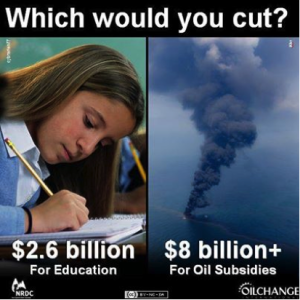
One of the most urgent reasons to eliminate fossil fuel subsidies is the rapidly dwindling carbon budget – the remaining amount of greenhouse gases we are able to emit while having a hope of staying below the temperature warming limits agreed to by world leaders. But, there is enough carbon in the fossil fuel resources already under development, globally, to surpass those limits. Simply put, we can not develop any new oil, gas, and coal resources and hope to stay on target. In this context, putting public money towards finding and burning more fossil fuels just doesn’t make sense.
Support for fossil fuel production also adds to the risks of “carbon lock-in”. Carbon- and capital-intensive infrastructure can last for decades, and investment in this infrastructure can mean that fossil fuel dependence – and the carbon emissions that come with it – get “locked in.” This makes the urgently-needed transition to climate-compatible energy pathways much more difficult.
Subsidies to fossil fuels support an industry that drives negative public health impacts, local environmental pollution from fossil fuel extraction and infrastructure, and climate change impacts and costs.
Fossil fuel subsidies essentially function as a negative carbon price, reducing the cost of developing fossil fuels – so not only are their true costs being shifted onto the poor via climate and health impacts, but the fossil fuel industry is actually being paid for this privilege.
Fossil fuel subsidies also take public money away from other uses. Public money going to fossil fuels could instead go to social spending, health and development, clean energy, energy access for the poor, or other areas important to the public.
How Much Money Do Governments Provide to Support the Oil, Gas, and Coal Industries Internationally?
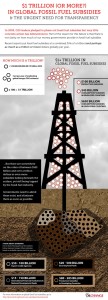
Internationally, governments provide at least $775 billion to $1 trillion annually in subsidies, not including other costs of fossil fuels related to climate change, environmental impacts, military conflicts and spending, and health impacts. This figure varies each year based on oil prices, but it is consistently in the hundreds of billions of dollars. Greater transparency in reporting would allow for more precise figures.
When externalities are included, as in a 2015 study by the International Monetary Fund, the unpaid costs of fossil fuels are upward of $5.3 trillion annually – which works out to a staggering $10 million per minute.
Oil Change International’s most recent reporting looks at money for fossil fuel production only (including exploration, and extraction, and development) in the G20 governments – which includes many of the world’s most developed countries. These governments are providing support to oil, gas, and coal companies to the tune of $444 billion per year, between direct national subsidies, domestic and international finance, and state-owned enterprise investment. See the More Info: Worst of the Worst section below for more detail.
You can find more information on the breakdown of global subsidies and international finance at our interactive website: energyfinance.org
How Much Money Does the Government of the United States Provide to Support the Oil, Gas, and Coal Industries?
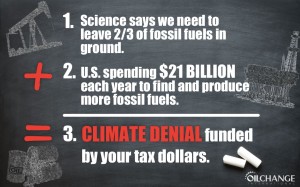
As of October 2017, Oil Change International estimates United States fossil fuel exploration and production subsidies at $20.5 billion annually. Other credible estimates of annual United States fossil fuel subsidies range from $10 billion to $52 billion annually – yet none of these include costs borne by taxpayers related to the climate, local environmental, and health impacts of the fossil fuel industry.
Fossil fuel subsidies in the United States also include massive military expenditures to acquire and defend fossil fuel interests around the globe, and infrastructure spending and related maintenance based on an antiquated energy system built on large, remote power plants and cheap electricity.
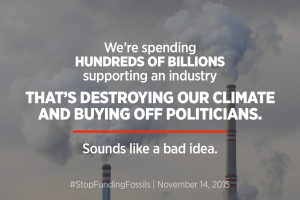
In 2017, the Trump Administration introduced its “energy dominance” agenda, largely predicated on speeding up oil, gas, and coal production through deregulation and dismantling of existing environmental and human health and safety rules. With a cabinet stacked with climate deniers and fossil fuel enthusiasts, the nation may likely be headed down a path of even greater handouts to oil, gas, and coal companies.
What Are Governments Doing to End Fossil Fuel Subsidies?
In 2009, the Obama Administration and the G20 nations proposed that they end “inefficient” fossil fuel subsidies. Although this commitment has generated repeated acknowledgments by the G20 and G8 (now G7), as well as some new studies and data, it resulted in very limited progress for many years. The 2016 G7 meeting was an important step forward, as world leaders committed to language urging all countries to eliminate inefficient subsidies by no later than 2025, and left the door open to an earlier phase-out for some countries.
2018 presents a unique opportunity to achieve real gains toward phasing out subsidies in other forums – G20 President China has committed to working with other G20 nations to set a “date certain” to phase out inefficient fossil fuel subsidies. China has also said that on a national level they will “strictly control public investment flowing into projects with high pollution and carbon emissions both domestically and internationally.”
As with most climate change solutions, a major stumbling block to reform is the power of the fossil fuel industry. As we’ve seen time and time again, the fossil fuel industry has a stranglehold on policy makers all around the world, and they love these handouts.
The principle is simple and clear: You can’t really say you’re committed to the fight against climate change if you’re still funding oil, gas, and coal. Many global leaders including the leaders of the G20 nations, U.N. Secretary General Ban Ki Moon, former climate talks leader Christiana Figueres, economist Nicholas Stern, International Energy Association director Fatih Birol, former U.S. Vice President Al Gore, OECD Secretary General Angel Gurría, and former BP CEO John Browne have spoken out against the ongoing practice of subsidizing fossil fuels with public funds. But until we break the grip of the fossil fuel industry over our energy policy, it will be much harder to make progress and eliminate subsidies.
We’re Fighting Back
The Clock Starts Now: A 2020 Deadline to End Subsidies
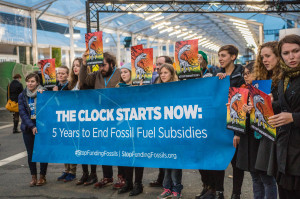
The science is clear. We have far more oil, gas, and coal than the world can afford to burn. And yet, each year governments around the world hand out hundreds of billions of our tax dollars to help fossil fuel companies exploit more unburnable carbon.
We are calling on global leaders to end all fossil fuel handouts by 2020.
G20 governments committed to phasing out inefficient subsidies in 2009, and they have repeated this commitment every year. This is not a radical ask. In fact, it’s demanded by science. The Paris Agreement in December 2015 was a watershed moment illustrating just how foolish these subsidies really are. Over 190 countries reiterated their commitment to limiting global warming to a maximum of two degrees Celsius, and to aim even lower.
In 2016, G7 leaders urged all countries to phase out fossil fuel subsidies by 2025. This was a welcome step forward, and as major economies, the G7 and G20 will have to act even earlier than 2025 if all countries are expected to end fossil fuel subsidies by that date. We need to keep the pressure on these governments to commit to phasing out fossil fuel subsidies by 2020 at the latest.
Fossil fuels have no place in a safe future, which is why continuing to prop up the fossil fuel industry with taxpayer money is an irresponsible waste.
It’s Time to #StopFundingFossils
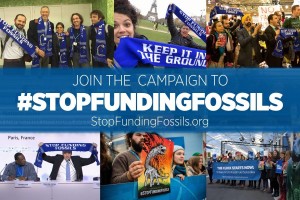
It’s time to #StopFundingFossils, and we’re building a worldwide movement to do just that. In 2015 we held an international Day of Action to Stop Funding Fossils with more than 60 partners. People took action in 10 countries around the globe, and activists sent tens of thousands of emails and messages to world leaders calling on them to stop propping up a deadly, dying industry.
The movement to #StopFundingFossils is just getting started, and we’re already seeing major progress as citizens stand up and highlight the ways their public money could be used in far better ways. We hope you’ll join us.
The United States Should Stop Handouts to Oil, Gas, and Coal
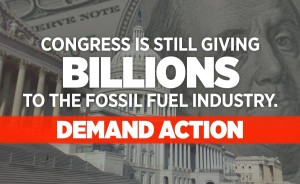
In each year of his administration, former U.S. President Barack Obama proposed a budget that included the elimination of billions in annual tax preferences to the fossil fuel industry. While these were nowhere near the entirety of the subsidies that this mature and very profitable industry enjoys, they were some of the most obvious. But Congress never even considered approving President Obama’s budget cuts to subsidies.
Current U.S. President Donald Trump has put in motion the reversal of many of Obama-era efforts to rein in the fossil fuel industry, including a moratorium on federal coal leases, an end to international support for the coal industry, and permanent protection of the Arctic and Atlantic Oceans from offshore oil and gas drilling.
The United States continues to fund oil, gas, and coal production abroad through international institutions like the World Bank and US institutions like the Export Import Bank and Overseas Private Investment corporation. Together, these institutions still provide billions of dollars in fossil fuel financing each year.
Now is the time for climate champions in Congress, statehouses, and governors’ residences concerned about the safety of the American public and the wise use of taxpayer dollars to push back on Trump’s fossil fuel agenda. Every dollar spent subsidizing this industry takes us further away from achieving internationally agreed temperature goals, and maintaining a stable climate.
More Info: The Worst of the Worst
Direct subsidies and public finance for the production and exploration of fossil fuels are particularly heinous because they prop up failing corporations, subsidize carbon which can never be burned, and actively undermine efforts to combat global warming and its deadly impacts.
Production Subsidies: Actively Undermining Commitments to Act on Climate
Productions subsidies are government support for fossil fuel production, including exploration, development, extraction, and transportation. We define support for fossil fuel production to include national subsidies, investment by state-owned enterprises, and public finance specifically for fossil fuel production.
G20 governments are publicly financing a bailout for some of the world’s largest, most carbon-intensive and polluting companies, to the tune of more than $444 billion per year, as highlighted in our 2015 report, Empty Promises. The United States and Russia lead the way with more than $20 billion in domestic production subsidies handed out each year, while other countries subsidize at higher levels through state-owned enterprises.
In effect, governments are propping up one of the richest industries in the history of the world: the production of oil, gas, and coal. Most of these fossil fuels can never be used if the world is to avoid dangerous climate change, so this support is tantamount to governments allowing fossil fuel producers to undermine national climate commitments, while paying them for the privilege.
As the world escapes the crushing grip of the oil industry, it is imperative that we transition away from all subsidies to oil, gas, and coal. However, not all subsidies are created equal – the intent of consumption subsidies in developing countries is often simply to help make access to energy and transport more affordable – even if they do not often accomplish this goal efficiently. While consumption subsidies must be phased out as part of the global transition away from an extraction-based, fossil fuel-powered economic system, a great deal of care needs to be taken in removing these subsidies so as not to harm the populations that rely on them for affordable energy. Production subsidies that support industry should be the first to go.
Exploration Subsidies: Subsidizing Dirty Fuels that Can Never Be Burned
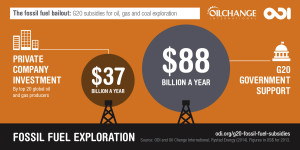
Exploration subsidies are government handouts specifically for the purpose of discovering and reaching new fossil fuel reserves, including support for extraction that includes an exploration component. It has become increasingly clear that we cannot afford to burn more than a small portion of the fossil fuel reserves we have already found, meaning exploration for even more reserves – and wasting public money doing so – is the height of irresponsibility.
G20 governments dump more than $78 billion of public money per year into subsidizing exploration for fossil fuels, as Oil Change International revealed in a 2014 report, Fossil Fuel Bailout. This continuing public support is a triple-lose situation:
- At least 75% – and possibly more – of known fossil fuel reserves must stay in the ground if humanity is to avoid the worst impacts of climate change, yet giving out exploration subsidies is dumping money into finding even more fossil fuels that can’t be burned.
- Exploration subsidies sap investment in alternatives like solar and wind power, undermining their competitiveness by giving handouts to some of the world’s richest oil, gas and coal companies.
- The hypocrisy of exploration subsidies undermines countries’ collective and individual commitments to act to limit climate change and its deadly impacts at the landmark international climate negotiations in Paris in 2015.
International Fossil Fuel Finance: Bailing Out the World’s Dirtiest Industries
G20 countries spent an average of $88 billion annually in finance for oil, gas and coal production in 2013 and 2014. These are government controlled investments that could instead be used to drive a clean energy transition.
Oil Change International tracks fossil fuel finance from multilateral development banks and bilateral financial institutions in G20 countries in its Shift the Subsidies database. Multilateral development banks (MDBs) – backed by governments – still provide billions of dollars each year in subsidies to oil, gas, and coal production.
Click here for a downloadable database of energy finance from these MDBs, taken from Oil Change International’s Energy Finance database.
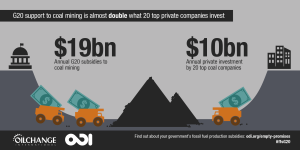
Coal – one of the dirtiest fossil fuels – benefitted from at least $73 billion in public support over the past 8 years, as revealed in our 2015 report, Under the Rug. That’s over $9 billion each year. Much of that support came from a handful of the world’s richest countries, aimed at boosting their large corporations that produce and export coal technology.
In 2015, governments took small steps to rein in this public support for coal, but much work remains. OECD countries, including longtime holdouts Japan, Australia, and Korea, agreed to establish some limits to international coal finance. Yet these countries continue to approve multibillion-dollar deals for coal power plants, including Japan’s recent contribution of $2 billion to back the proposed Batang power plant in Indonesia.
Over the past 8 years, Japan has provided the largest amount of coal financing of any country – over $20 billion, with Korea coming second among OECD countries. Governments need to move beyond the OECD agreement – they need to stop using public money to fund coal plants now.
Coal combustion is responsible for nearly half of global emissions that cause climate change, and health damage caused by coal is estimated at as much as $500 billion per year in the United States alone, with damages in China many times that figure.
